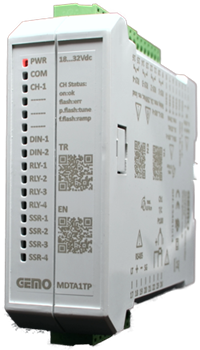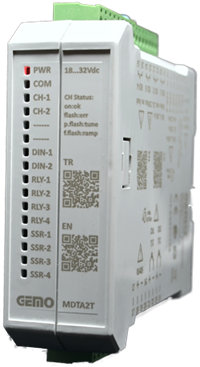MDTA Series DIN Rail Mounted PID Temperature Control Devices
- DIN rail mounted single channel enhanced PID temperature control device with MODBUS RTU protocol
- Works independently as a control device after parameters are set and loaded
- Parameters may be programmed either by MODBUS messages, or via GEMOModuleMaster software.
- Parameters may be saved and loaded to/from a file, may also be loaded and uploaded to/from a device by GEMOModuleMaster software. GEMOModuleMaster is freeware and may be freely downloaded from www.gemo.com.tr
- Single channel sensor type: T/C (J,K,T,S,R), Pt100, selectable, multi-input
- Selectable 0.1 oC resolution for J,K,T and Pt100
- 4 Relay outputs
- 4 SSR outputs
- 2 Digital inputs
- 4 independent Alarm blocks
- Relay and SSR outputs may be routed to any Control or Alarm blocks.
- Relay and SSR outputs may be used as general purpose outputs via NetIn contacts that may be accessed via MODBUS messages
- Digital inputs may be used as general purpose inputs as boolean inputs that may be accessed via MODBUS messages
- 18...32Vdc isolated supply
- Single RS485 line for MODBUS RTU communication
- Selectable baud rate: 9600, 19200, 38400 bauds
- Selectable odd, even, no parity, one stop bit, two stop bits
- Internal line termination circuit that may be activated with a single external short circuit
- LED panel to monitor input/output status
- Auto-tuning for PID parameters
- Selectable control type: P, PI, PD, PID or ON-OFF
- “Anti-windup”
- Selectable overshoot reduction
- Minimum 1 second PID control period
- 2 independent SET points (SET1 & SET2) for each channel that is selectable by digital inputs
- Selectable relative, absolute, band or sensor failure alarm for each Alarm block independently
- ON-delay for OUT in cooling mode
- Ramping after power on (soft-start)
- Cold-junction compensation for T/C
- Line compensation for Pt100
- Excellent linearity with oC/mV and oC/Ohm look-up tables
- Input “Offset” feature
- High accuracy
- EEPROM memory to store settings
- Easy connection with plug-in connectors

- DIN rail mounted double independent channels enhanced PID temperature control device with MODBUS RTU protocol
- Works independently as a control device after parameters are set and loaded
- Parameters may be programmed either by MODBUS messages, or via GEMOModuleMaster software.
- Parameters may be saved and loaded to/from a file, may also be loaded and uploaded to/from a device by GEMOModuleMaster software. GEMOModuleMaster is freeware and may be freely downloaded from www.gemo.com.tr
- Double channel sensor type: T/C (J,K,T,S,R), selectable for each channel independently; multi-input
- Selectable 0.1 oC resolution for J,K,T
- 4 Relay outputs
- 4 SSR outputs
- 2 Digital inputs
- 4 independent Alarm blocks
- Relay and SSR outputs may be routed to any Control or Alarm blocks.
- Relay and SSR outputs may be used as general purpose outputs via NetIn contacts that may be accessed via MODBUS messages
- Digital inputs may be used as general purpose inputs as boolean inputs that may be accessed via MODBUS messages
- 18...32Vdc isolated supply
- Single RS485 line for MODBUS RTU communication
- Selectable baud rate: 9600, 19200, 38400 bauds
- Selectable odd, even, no parity, one stop bit, two stop bits
- Internal line termination circuit that may be activated with a single external short circuit
- LED panel to monitor input/output status
- Auto-tuning for PID parameters
- Selectable control type: P, PI, PD, PID or ON-OFF
- “Anti-windup”
- Selectable overshoot reduction
- Minimum 1 second PID control period
- 2 independent SET points (SET1 & SET2) for each channel that is selectable by digital inputs
- Selectable relative, absolute, band or sensor failure alarm for each Alarm block independently
- ON-delay for OUT in cooling mode
- Ramping after power on (soft-start)
- Cold-junction compensation for T/C
- Excellent linearity with oC/mV look-up tables
- Input “Offset” feature
- High accuracy
- EEPROM memory to store settings
- Easy connection with plug-in connector






